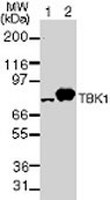AM76 Sigma-AldrichAnti-TBK1 Mouse mAb (108A429)
This Anti-TBK1 Mouse mAb (108A429) is validated for use in Immunoblotting for the detection of TBK1.
More>> This Anti-TBK1 Mouse mAb (108A429) is validated for use in Immunoblotting for the detection of TBK1. Less<<Recommended Products
Overview
| Replacement Information |
|---|
Key Spec Table
| Species Reactivity | Host | Antibody Type |
|---|---|---|
| H | M | Monoclonal Antibody |
Products
| Catalogue Number | Packaging | Qty/Pack | |
|---|---|---|---|
| AM76-100UG | Plastic ampoule | 100 μg |
| Product Information | |
|---|---|
| Form | Liquid |
| Formulation | In PBS, 0.2% gelatin. |
| Negative control | Normal mouse serum |
| Positive control | HEK293 cells |
| Preservative | ≤0.1% sodium azide |
| Quality Level | MQ100 |
| Applications | |
|---|---|
| Key Applications | Immunoblotting (Western Blotting) |
| Application Notes | Immunoblotting (2 µg/ml) |
| Application Comments | Antibody should be titrated for optimal results in an individual systems. |
| Physicochemical Information |
|---|
| Dimensions |
|---|
| Materials Information |
|---|
| Toxicological Information |
|---|
| Safety Information according to GHS |
|---|
| Safety Information |
|---|
| Product Usage Statements |
|---|
| Packaging Information |
|---|
| Transport Information |
|---|
| Supplemental Information |
|---|
| Specifications |
|---|
| Global Trade Item Number | |
|---|---|
| Catalogue Number | GTIN |
| AM76-100UG | 04055977228045 |
Documentation
Anti-TBK1 Mouse mAb (108A429) SDS
| Title |
|---|
Anti-TBK1 Mouse mAb (108A429) Certificates of Analysis
| Title | Lot Number |
|---|---|
| AM76 |
References
| Reference overview |
|---|
| Pomeerantz, J.L. and Baltimore, D. 1999. EMBO J. 18, 6694. Didonato, J.A., et al. 1997. Nature 388, 548. Lee, F.S., et al. 1997. Cell 88, 213. Malinin, N.L., et al. 1997. Nature 385, 540. Mercurio, F., et al. 1997. Science 278, 860. Regnier, C.H., et al. 1997. Cell 90, 373. Verma, I. and Stevenson, J.K. 1997. Proc. Natl. Acad. Sci. USA 94, 11758. Verma, I.M., et al. 1995. Genes Dev. 9, 2723. |














